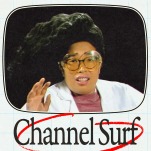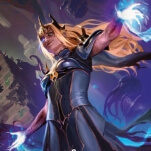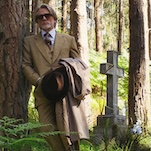The Middleman died too soon, only to live on, like a trout-craving zombie
If you’ve never seen or even heard of the eccentric 2008 ABC Family series The Middleman, and you need some indication as to whether the show is something you might enjoy, let me ask this: Are you the kind of person who’d dig it if a TV episode about a zombie plague was littered with references to the ’60s British rock band The Zombies? I mean, c’mon. Tell me no.
The Middleman ran for 12 episodes in the summer of 2008, then disappeared, just out of reach, into the rarefied realm of the unjustly ignored, where ever since it’s been waiting to graduate to full-on “cult favorite” status. The people who made The Middleman were prepared for that to happen. They took what they were given and made it their own, stuffing the show with in-jokes and homages designed to reach exactly the people inclined to like this kind of show, whenever they’re ready. One of The Middleman’s writers, Andy Reaser, told me that even now, years after the show’s cancellation, the people who worked on it are still so hung up on the dream of this show that they email each other jokes that they could’ve used. (It also says something about The Middleman team’s devotion that when Reaser found out I was going to be writing about the show, he reached out and offered any help he could give, before it had even occurred to me to contact him.)
Here’s the best way to describe The Middleman: Imagine if Joss Whedon and Amy Sherman-Palladino collaborated on a secret-agent/science-fiction/superhero script, then handed it off to be directed by John Carpenter, with cinematography by Barry Sonnenfeld. Created by Javier Grillo-Marxuach (who so believed in the premise that he wrote it as a comic book series first when he couldn’t sell it as a TV show), The Middleman stars Natalie Morales as lovelorn art student Wendy Watson, a.k.a. “Dub-Dub” or “Dubby.” She gets recruited by a straight-arrow covert operative known only as “The Middleman” (played by Matt Keeslar) to join an organization that’s been using comically fake IDs and advanced technology to combat “threats intra-, extra-, and juxta-terrestrial” for generations. Whenever aliens infiltrate, super-apes join the mob, sorority houses get haunted, or trout-craving zombies arise, Middlemen rush to the rescue, with weapons drawn and rapid-fire repartee at the ready.
The trout-craving zombies surface in the Reaser-penned episode “The Flying Fish Zombification.” Wendy receives a call from The Middleman’s acerbic android assistant Ida (Mary Pat Gleason), who explains that a man named Rod Argent was just attacked by his wife Bonnie Blue. While they were on a camping trip, Bonnie freaked out, started groaning, “Troooooout,” and threw an RV at Rod. After subduing Bonnie and determining that Rod hasn’t been turned into a zombie fish-fiend himself—which The Middleman does by threatening to kill Rod, just to make sure that he still has an instinct for self-preservation—the heroes investigate the Beechwood Park RV Park, where Wendy fights off and kills a Peruvian Flying Pike, just as Ida is informing The Middleman that the only way to save Bonnie is to capture the rare Peruvian Flying Pike alive.
Luckily, Wendy notices that the pike bears the brand of the nearby Odessey And Oracle Fish Hatchery, so the two Middlemen go there and discover tanks full of pike, along with several goons preparing a shipment for a mysterious “Mr. White.” Realizing that a trout-craving zombie plague may be imminent, The Middleman searches for another victim to question, and comes up with Heidi, a wannabe spokesmodel who explains that her trout hunger started after she auditioned for a job promoting !!!!, a new energy drink whose name is “pronounced” by stomping feet, flashing palms, and grinning.
Wendy and The Middleman quickly find the !!!! factory, and confront Mr. White (played by Todd Stashwick), who confesses that he himself was infected by a Peruvian Flying Pike, and then was saved by an antidote provided by an Amazonian tribesman, which gave Mr. White the idea to manufacture a beverage laced with PFP venom and trout, thus creating scores of !!!! addicts. The heroes overcome Mr. White’s army of zombified !!!! spokesmodels, then defeat Mr. White himself. (He gives off a little Wilhelm Scream as he goes down, as is typical of Middleman villains.) Any remaining !!!! zombies are cured by an antidote synthesized from a pike The Middleman liberated from the Odessey Hatchery, carrying the beast out in a giant, fish-sized scuba-suit.
As always with The Middleman, the primary world-saving plot is just one major element of “The Flying Fish Zombification.” There’s also a running passive-aggressive tussle between Wendy and The Middleman over the former’s endorsement by the hard-to-please Middleman trainer Sensei Ping. Initially, The Middleman is proud that the sidekick he himself recruited has impressed his sensei, but the more Wendy tosses Sensei Ping quotes in his face, and demonstrates special martial-arts moves that The Middleman thought only he’d been taught, the more jealous the boss becomes. Eventually, Wendy begins to suspect that The Middleman’s grudge is causing him to overstate the trout-craving zombie threat, just to sabotage Wendy’s evening plans.
Those plans constitute the other big plot thread in “The Flying Fish Zombification.” As the on-screen titles frequently explain, Wendy shares “An Illegal Sublet With Another Young, Photogenic Artist,” Lacey Thornfield (Brit Morgan), and Wendy and Lacey host an event called “Art Crawl” in their building, featuring painting and performance art. Their cool neighbor Noser (Jake Smollet) regularly does an act he calls “Stump The Band,” in which he stands onstage with a guitar, takes requests from the audience, and then nods, “Yeah, I know it,” without ever playing a note. Their annoying neighbor Pip (Drew Tyler Bell) intends to torture the crowd with his epic monologue “Hey Mr. God,” featuring such truth-to-power lines like, “What’s with all the poor people?!” Lacey, meanwhile, is known for her “confrontational spoken-word stylings,” which she’s looking forward to showing off to her world-renowned humanitarian mother Dr. Barbara Thornfield, M.D., Ph.D. (Middleman characters always include both honorifics when saying Dr. Thornfield’s name.) But Dr. Barbara Thornfield, M.D., Ph.D. gets called away for a meeting with Henry Kissinger—“Cambodia, Chile… now Art Crawl,” Wendy laments—and it doesn’t help Lacey’s mood that Wendy’s own Art Crawl arrival keeps getting delayed by Middleman business. Then, when Wendy finally does show up, and Lacey starts to perform, The Middleman pops in and takes Wendy away again. The Middleman was always attuned to that reliable old Marvel Comics theme: sometimes superheroism sucks.
By and large, The Middleman writers, directors, and cast maintained a breezy tone, which sometimes made the show feel a little too low-stakes. But any frothy goofiness was usually countered by the depth of the performances—especially from Morales, who shifts easily from peppy to snide to heartbroken. Plus, Grillo-Marxuach and company knew just what to nick from other pop-savvy and/or science-fiction-oriented series. At its best—and The Middleman had a remarkably high batting average over the course of its 12 episodes—the show could simultaneously recall The Venture Brothers in its allusions to a long, noble, gradually decaying legacy, Buffy The Vampire Slayer in its celebration of a smart-mouthed, uncannily gifted heroine, The Hitchhiker’s Guide To The Galaxy in its vision of a meaningless universe that presents the illusion of purpose via a complex bureaucracy, and Gilmore Girls in its rapid-fire patter, rife with obscure pop-culture references.








































